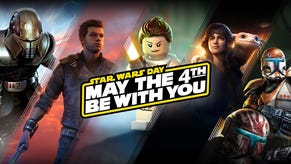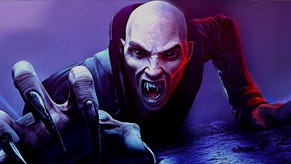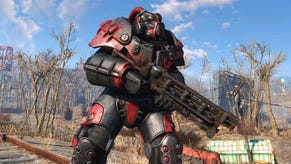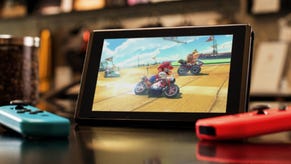Schafer on Happy Action Theater and Kinect's future
Tim Schafer has made a Kinect game playable by two year-olds. Simple? Not. Patrick Garratt speaks to the Double Fine boss on the difficulty in reducing sophistication and whether or not Kinect can ever appeal to the core.
Double Fine's Happy Action Theater is not a game. It's a $10 toy you download for Kinect and present to your small children. As you'll know if you have a two year-old child, video games are a failure for the very young. They're too complex and the control input baffles tiny hands. While Kinect, in theory, should have done away with all that thanks to its supposed motion revolution, there's never been a product suitable for what amounts to an insane human being with an utterly different perception to you or I.
Tim Schafer plans on changing that tomorrow.
Schafer spoke to me on the phone from the US last night on the thinking behind Happy Action Theater, the future of Kinect, independent development and hat preferences.
VG247: The idea for Happy Action Theater originally came from you wanting to make a game your two year-old daughter could play. I've watched a few videos of it and it does look extremely simple. I've got three kids, all under the age of six, and my twin boys have just turned three. Watching it, I can actually imagine them playing with it and getting it. I can't think of a single other game about which I can say that. How difficult was it to strip away sophistication to the degree that a two year-old can honestly get a video game?
Tim Schafer: Well, it was a simple idea, and really hard to keep up the discipline of not adding things that would alienate that kind of player, whether it's a two year-old or an adult at a party, or someone who doesn't want to mess with anything - doesn't want to be signing in, doesn't want to mess with profiles, doesn't want to mess with rules or tutorials. These ideas would keep coming up; someone would be like, 'Hey we should add Achievements,' and we did add Achievements, but then people wanted to add deeper rules, and score-keeping, and some sort of unlockable depth to the game. That kind of feature creep is really dangerous to a game like this, because even though it seems really simple it's really deceptive because it's very powerful when you put kids in front of it and see how much they're able to make out of it.
This is the thing that I always find with kids' games. They are never, they simply cannot be simple enough in the current format. They're too complicated.
Kids are chaotic. I was really frustrated that the games we had couldn't handle the chaos of her running out of the room and running back in, or getting too close to the screen, or laying down on the floor and grabbing my legs. If you have a little kid you know they want to hold your hand and grab your leg and get behind you and go on your shoulders and do all this crazy stuff when you're playing together. And the goal was to make a game that wouldn't be bothered; it would not break when chaos came, but actually would thrive on chaos, so that the game is actually at its best when it's chaotic, with a room full of anarchic children playing.
Watching it, it does seem to be more of a toy than a game, which is exactly perfect for a two year-old kid. I watched you do the GiantBomb demo, and saw the lava level. Watching you and Ryan play that reminded me of my boys playing with something like Play-Doh, just fiddling around with something - there's no real point to it especially, because kids think in a completely different way. Was it difficult to get your developers, who may not have experience of very young children, to get into their heads that that's what a child might want to do?
It's more of a toy. It's really hard when you talk to a core game player, and they ask about how many hours of gameplay there is. How many hours is Play-Doh? It's a difficult question to answer.
We made them so they were fun for us, in the office, for the developers, and then kids showed us new ways to make the activities fun. The lava's a great example of something that I thought would be fun. What I remember from being a kid is playing Hot Lava in the kitchen, where you had to climb onto the kitchen counter and not step on the floor, get across the living room on the surface of the couch without touching. That's how I thought it would be fun. When the kids played it, they immediately flopped into the lava, swam in it, splashed in it, kicked their feet up in the air. We didn't anticipate this way being fun.
So we added gameplay there; we added the ability to get into the lava and get back up again, and now you have fire hands! Now you can throw the fire hands around. We went out of our way to make sure the game never had a point, because that would ruin it. I mean that in the best possible way. It's meant to be the best possible waste of time. It's not a waste of time in that it's really, I think, inspiring to kids' imaginations. Kids have great big imaginations but they sometimes need a suggestion or a background or a reminder to what the fantasy is. That lava helps them. Then they can pretend they're hot lava monsters, or they can do hot touch, they can do whatever they want in front of the lava and make up their own game. It is more of a toy. It's really hard when you talk to a core game player, and they ask about how many hours of gameplay there is. How many hours is Play-Doh? It's a difficult question to answer.
You've got 18 activities in there, but I'm assuming Happy Action Theater was relatively cheap to make. This is the new Double Fine, with your idea of making low cost, downloadable games. Was this a common sense project for you? Did it fit well with what you're doing with Double Fine at the moment?
Yeah. I mean, it's even smaller. We split into four teams after Brütal Legend and made four games with teams of like 12 people, and this was a team of six. It was very small. I signed it over the phone with Microsoft, and I didn't have to do a big complicated presentation or get a demo together. It was very like, "Let's just do this, let's not over-think this."
Trying really hard not to over-think it has been a mantra throughout the whole project, definitely in the pitching of it and in getting it done. As we saw the game go together and tested it and people started to see the impact it would have on kids, or just adults, we started investing a little more money in it just to polish it up and make it look really nice. But it was actually the possibility of the gameplay that was apparent to everybody. It's hard when you pitch it, 'cause people might think it looks like a webcam game, or something that you could have done on the EyeToy years ago, but it's not. If you really look at it with a programmer's eye you can see what we're doing stuff with the depth buffer and augmented reality, it's actually really high tech and could only have been done on Kinect.
Talking about the technicality of it, Kinect, as with all motion cameras, does have issues with detection sometimes. One thing that two year-old children get very quickly is incredibly bored; when they're playing something and it doesn't behave in the way they want it to they're going to lose attention very very quickly. Was it a key aspect for you to make sure it was fully responsive to what the child was doing in front of the screen?
Yeah. You could watch it and see what kids would do. You can see that they would want to sit there in the snow level, and they want to throw snowballs. They want to kick the snow around with their feet. You kind of see them doing this activity and it's like, "What are they doing? Oh, they're trying to kick the snow around. We have to make the snow kickable."
We would follow the kids and create emergent gameplay for them on the fly based on what they would tend to do. As long as the game is always reacting to you, we don't have any detection problems. That's just the game we have; we don't need to match any really difficult gestures, and we're not using the skeletal tracking as much as most Kinect games are. We're using the player blob, just identifying these rough blobs that represent players, so we just needed to know roughly where you are and what your shape is, and we can do all kinds of crazy things. We can cast shadows from the player onto the virtual objects in the scene with you - and vice versa, we can light you up; when you hold fireworks in the game, the fireworks can cast light on you. We can wrap lava around your couch in your living room.
And then we can do some of the coolest stuff. We can actually remove you from the scene because we record what your living room looks like without you, as you move around the screen while we build a background plane. In the fish tank, for example, you get pulled up by one of the fish hooks, or if the lava breaks and you burn, you're gone from the scene. Which seems kind of natural at first because the fish hook drew you up, but then you're like 'Wait, I'm looking at my living room, and everyone's here but me'. It's pretty cool.
I think the best games for Kinect are games that were, like the Happy Action Theater, created wholly from scratch for the Kinect. They're just designed for it. It's not a replacement for an Xbox controller. There's no right button, there's no pressure in the left stick - it's not a port. You can't port your game to Kinect.
Kinect at the moment seems fine for high-latency software aimed at youngsters, and dance games have been very successful on it, but it's difficult to argue that it's working well for the core. This game works specifically because of what you said - it is high latency, kids do specific things and it doesn't have to track them exactly. Do you think that we're ever going to see core games aimed at adults with the current device, or do you think we're going to have to wait for a hardware upgrade?
I don't know; I think a lot of core people are working on that problem. I've been focussing on it as a device for families, just because I think that's a really natural thing; try to think of who likes to stand up in the living room, and who likes to zone out on the couch. A family together is more likely to stand up and hop round and look goofy than the hardcore games player. I can see a hardcore player playing some sort of mixed martial arts game or something, where there's kicking, doing all sorts of physical activity. But it is a barrier, getting some of them to move their coffee table and get into it and stand up, have them willing to do stuff with their full body.
It is great for people who have not been typically playing games. My mom, I can see her standing in front of the Happy Action Theater, and playing without help and not feeling impaired. But when you hand her a controller, she looks at it like, "Woah, what the heck is that thing?" Like it's a bear trap.
It's interesting you say that; you said at the start of the GiantBomb video that there are still barriers with Kinect games. That's fairly ironic given Kinect was supposed to be the device that did away with the UI and opened up the entire notion of games to people like your mum or your daughter. Do you think in a sense developers are still really feeling their way with motion? That they haven't quite got it yet?
I think they're still trying to figure out how to make great games for Kinect. I think the best games for Kinect are games that were, like the Happy Action Theater, created wholly from scratch for the Kinect. They're just designed for it. It's not a replacement for an Xbox controller. There's no right button, there's no pressure in the left stick - it's not a port. You can't port your game to Kinect. You really have to start from the beginning and think about all the motions that the Kinect sensor is good at picking out, and all the activities that it picks up really well that have never been able to be detected before. Like directional voice; it can tell where in the room you're talking from. Basing work around those strengths, I think, will lead to the best Kinect game.
This is your second Kinect game, so obviously you've got a better view than most about what's going on with console motion control at the moment. Looking forward, how important do you think it's going to be in the rest of this generation and moving into the next one?
I think it has a lot of potential, especially like I said for family games and physical games. I think it's much more inclusive. It lets a lot of people people come in and play games who hadn't been able to before. I think it will continue to grow in that area. I think it's really important for consoles to provide something that can't be provided by an iPhone.
Or a PC.
Or a PC. Well, there is going to be Kinect and Kinect-like things on PC really soon. You see the Kinect hackers doing all these crazy things, but there's not a lot of products yet for Kinect on PC. I think it will eventually come to PC. I still think it's not going away.
I can see a hardcore player playing some sort of mixed martial arts game or something, where there's kicking, doing all sorts of physical activity. But it is a barrier, getting some of them to move their coffee table and get into it and stand up, have them willing to do stuff with their full body.
You saw it on mobile devices. There were a lot of games that were ports of existing types of games, but it took people a while to realise that tapping and dragging and sliding on a touch tablet is really different from using a controller. Games have started to emerge, especially this year, that are designed for a tap interface and work a lot better, and you can't port them backwards to a PC or a console. They're starting to come into their own; I think that'll happen with Kinect.
Talking about business a little; you switched Double Fine's strategy completely after Brütal Legend, and you stopped working with bigger publishers like EA and aimed straight at downloads with smaller, cheaper games. I went to Finland recently and every developer I met was doing exactly the same thing. Do you think this is a necessary tack if you want to stay independent? These guys were saying that triple A for independents is essentially dead. Would you agree with that?
It's very hard to convince a publisher to give a lot of money for a new IP, a risky IP, especially when there are some really big, safe bets they can make. The more money you take from a publisher the less autonomy you have. We have a great relationship with Microsoft on this project; they let us make the game exactly like we wanted to make it. But we were asking for a small enough amount of money.
You know, Brütal Legend was a big expensive game, and I don't know if we could sell something like that right now. Well, I can tell you, we probably can't - it's really hard to. It's the end of the console cycle and people are being less and less experimental with new IP. There are a lot of pressures that make it more advantageous to an indie developer to do smaller games because the less money you're spending the more autonomy and control you have.
And also the more things you can make. In our first ten years we only made two games, and [following Brütal Legend] we've shipped four. February 1 we're shipping - in the States - Happy Action Theater and a DLC pack for Iron Brigade. That's the first time we're shipping two things on the same day. It's fun, because we get to try a lot of different things. Instead of taking a huge bet on one game every four years, we're a lot better off to take smaller bets on a couple of games a year.
I suppose there's an awful lot less risk.
Yes. And a lot more fun. We specialise in coming up with new ideas, and the more often we get to come up with a new idea the better.
Are you looking at mobile and tablets for future games?
You know, Brütal Legend was a big expensive game, and I don't know if we could sell something like that right now. Well, I can tell you, we probably can't - it's really hard to. It's the end of the console cycle and people are being less and less experimental with new IP. There are a lot of pressures that make it more advantageous to an indie developer to do smaller games because the less money you're spending the more autonomy and control you have.
I think so, yeah. I mean, now that I have one I can't help but think, "What would be a fun game for this?" There's a lot of ideas floating around for mobile and tablet type experiences.
I'm assuming GDC this year is going to be nothing but tablets, mobiles, browsers. I was really stunned when I went to Finland just how heavily these guys are focussing on really cheap games on non-traditional platforms. Are you expecting that from GDC?
I never know what to expect at GDC! I definitely know that there is an appeal in that for us. There's a lot of potential in having a game on a platform that everybody has. I come up with ideas for it every day.
What's going on with the turn of the century, cloth cap urchin thing with Double Fine? It's all very Dickensian. Where did that come from?
The what? Turn of the century pop cap? What?
You've always got this sort of 19th Century, early 20th Century thing going on. You had it in Stacking as well. You've got it in Happy Action Theater; you've got the menu inhabited by little boys in cloth caps.
Oh! Oh, I thought you were saying pop caps. "What do you mean, 'Pop caps?'"
Cloth caps.
What is it with pub caps? You know, that's the same. Well, I don't want to say we stole assets from Stacking, but we did have some hats hanging around. You know those caps, they just look good. Come on.
Everyone needs a cloth cap Tim. I know I do.
Exactly. I always call them pub caps but you - what's that word?
Cloth cap.
What? How do you spell that?
Cloth cap. As in a piece of cloth: and a cap.
[Sounding very different with a US accent] Oh, cloth cap!
That's it.
Cloth cap. I blame Lee Petty, the guy who came up with Stacking and he helped out with Happy Action Theater. Maybe he has a thing for cloth caps. Maybe he wants one for Christmas.




_O9MlrWs.png?width=291&height=164&fit=crop&quality=80&format=jpg&auto=webp)






